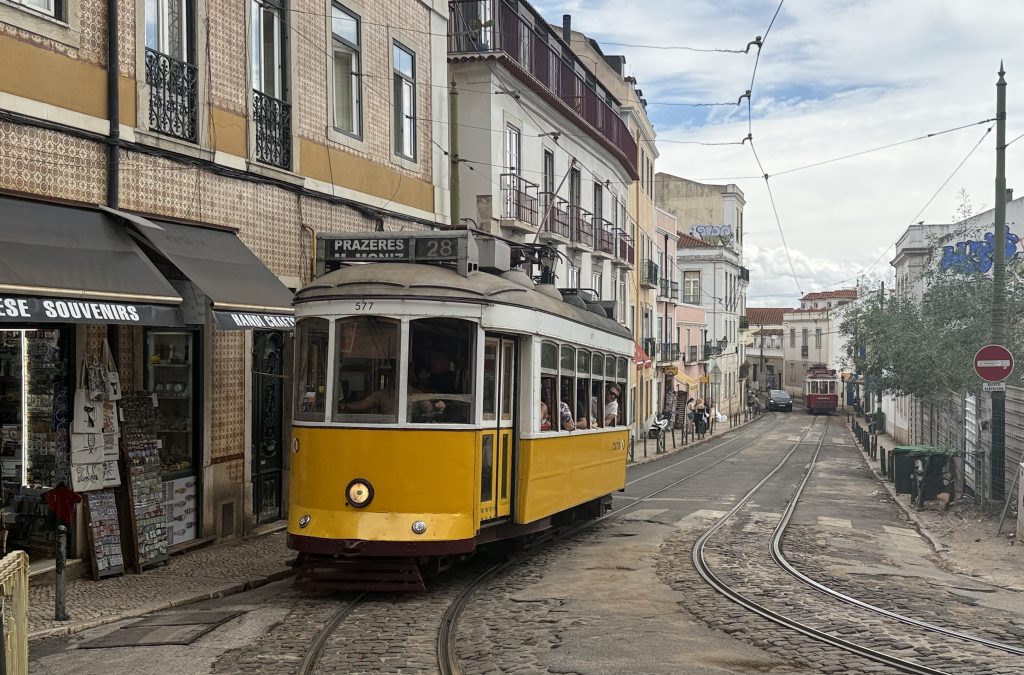
Before setting out to hike part of Portugal’s Fisherman’s Trail with Intrepid Travel, I added a couple of extra days on each end to explore Lisbon. Three before the trip, two after—five days in total. I thought that would be enough. I’m not sure it was. Lisbon is one of those cities where you always want just a little more time — to wander, to sit in a café, to hop on another tram, or just follow whatever street catches your eye.
In all, we hiked about 83 kilometers over six days, plus a rest day in the middle and travel days on either end — eight days start to finish. The route followed the Rota Vicentina’s Fishermen’s Trail, beginning near Porto Covo and ending in Sagres, right at the edge of mainland Europe. (click here)
Lisbon bookended that journey, and here’s how I spent those five days — from tiled façades and tram rides to a sidecar tour, a day trip to Sintra, and plenty of pastéis de nata along the way.
Lisbon—Portugal’s capital—is one of Europe’s oldest cities, known for its steep hills, yellow trams, tiled façades, fado, seafood, and pastel de nata (pahs-TELd-NAH-tuh). More than anything, though, it’s a city that feels good to wander.
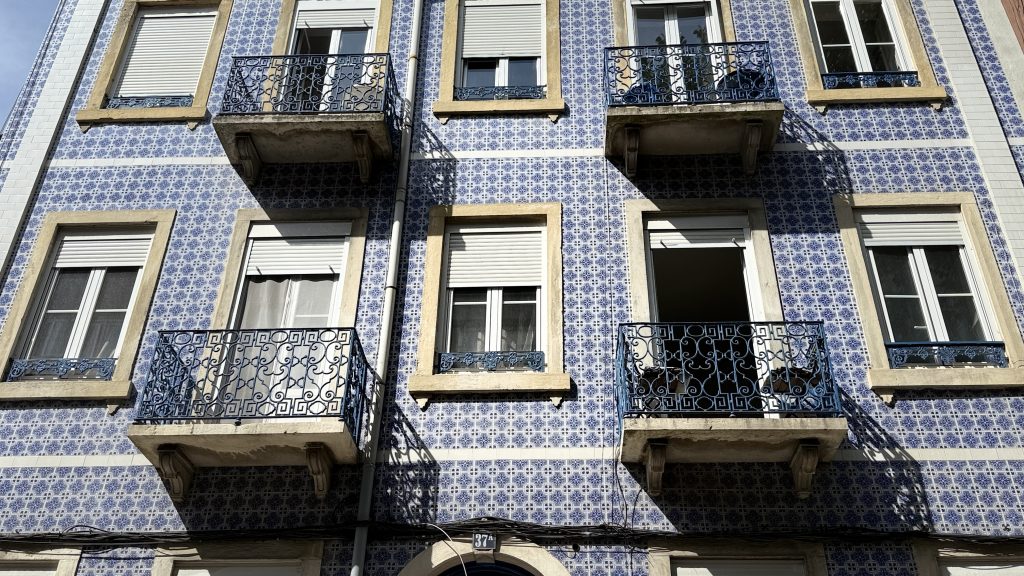
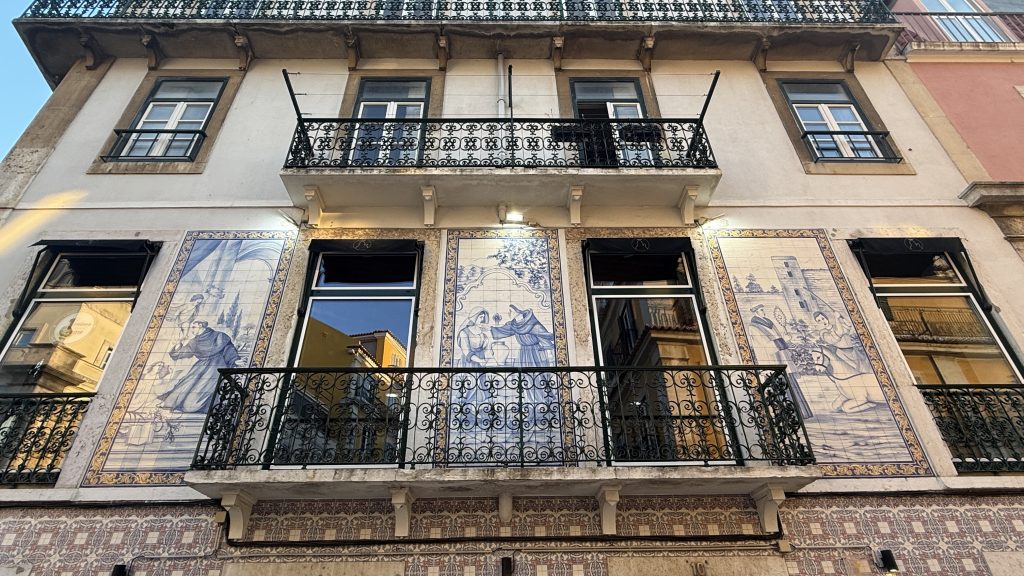
Lisbon is a patchwork of neighborhoods, each with its own personality. In Baixa (BYE-shuh), the historic downtown, everything was rebuilt after the 1755 earthquake. Chiado (shee-AH-doo) is elegant, with cafés and theaters. Alfama (ahl-FAH-muh), the oldest quarter, is a maze of lanes and fado houses, while Bairro Alto (BYE-hoo AHL-too) is known for nightlife and hilltop views. And beyond those, the city’s many other districts each have their own look and personality.
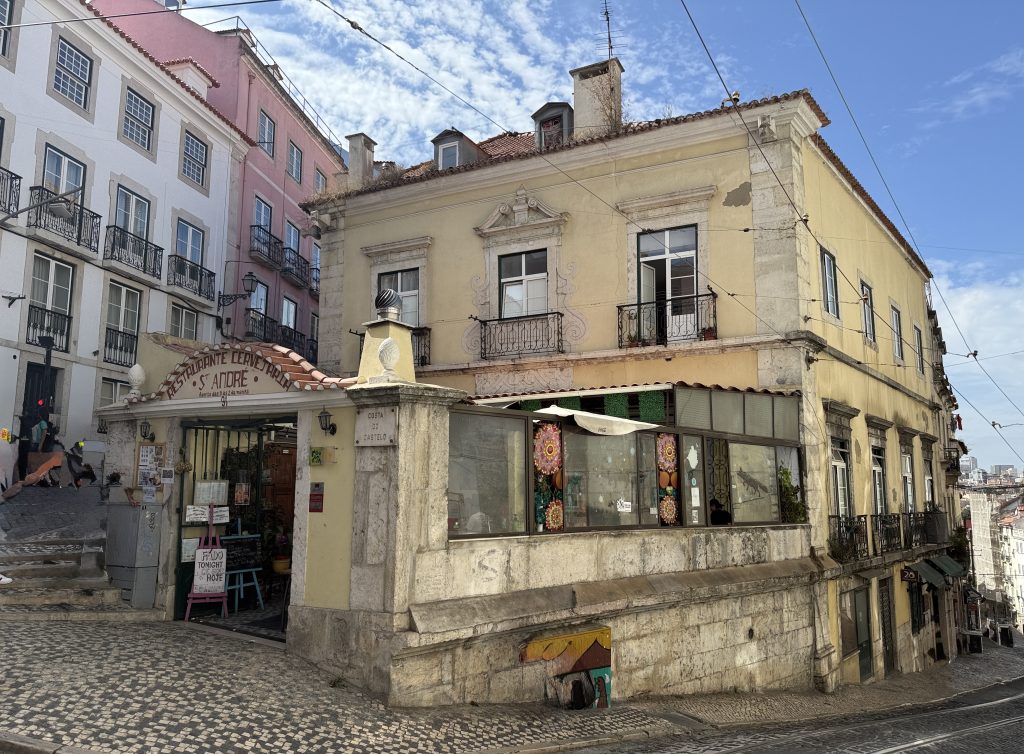
Normally, funiculars make climbing Lisbon’s steep hills a lot easier. Just before I arrived, though, there had been a tragic accident on the Ascensor da Glória, and all four funiculars — along with the Santa Justa elevator — were closed for investigation.
I connected through Munich, where I went through passport control since Germany is my entry point into the Schengen zone (most of mainland Europe shares a common border system). The line was quick, just a stamp in my U.S. passport, and that was it. Because of that, when I landed in Lisbon there was no passport check — I just walked straight out.
I checked into Brown’s Central Hotel for the first part of my stay. The hotel sits on a quiet, pedestrian-only side street in Baixa, just a block off Rua Augusta. It was a great location. My cab driver had dropped me nearby, pointed me in the wrong direction, and left me to figure it out. With no big sign out front, I wandered a bit before my GPS finally set me straight — deep breath.
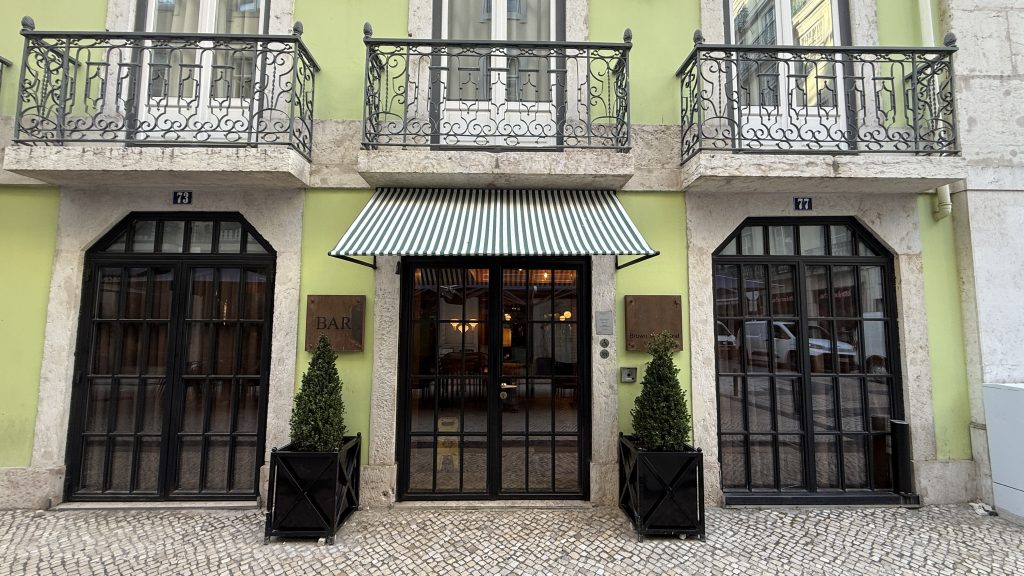
My room wasn’t large, but it was clean and comfortable — with pillows that were just right (not the overstuffed kind I can’t stand). The staff were warm, even sending me to the bar for a complimentary drink.
After a quick nap, I headed out to explore the streets, keeping an eye out for Lisbon’s tiled façades. One of the first that caught my eye was the Casa de Ferreira das Tabuletas in Chiado, its entire front covered in ornate 19th-century tiles.
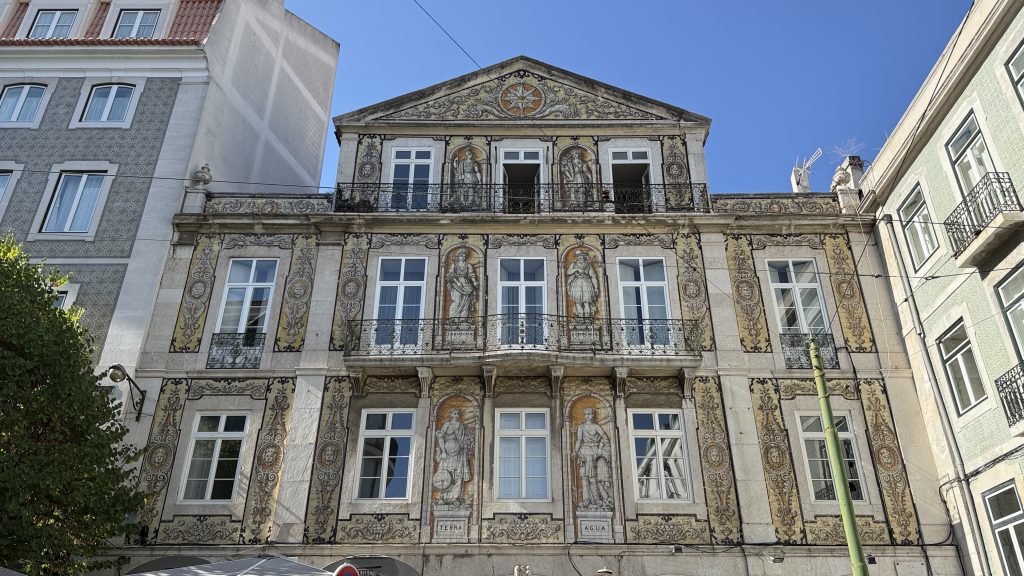
From there, I wandered down café-lined alleys to the Miradouro de São Pedro de Alcântara (a popular viewpoint),where the view stretched across Lisbon’s rooftops to Castelo de São Jorge and the Tagus River.
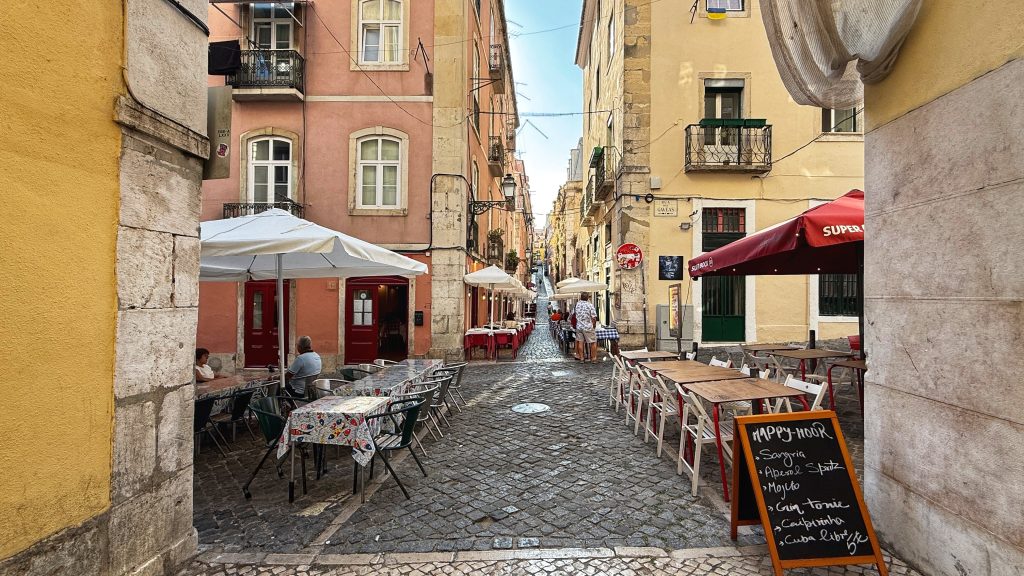
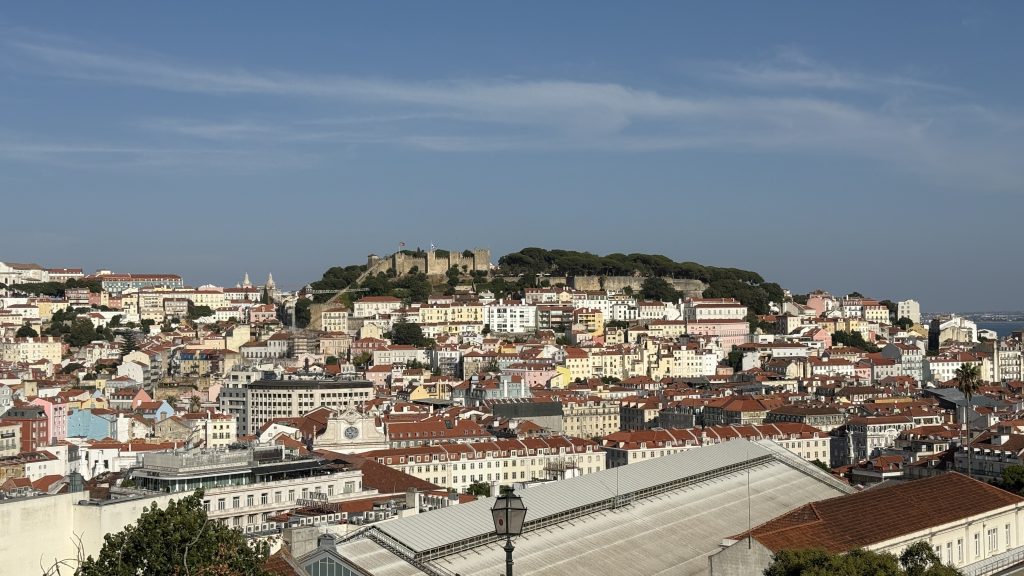
Feeling hungry, I headed toward the São Bento neighborhood to check out a couple of spots I’d seen highlighted on the travel show, Somebody Feed Phil.
First up was La Pizza di Nanna, a tiny takeaway counter where the pizzas are baked in wide trays and cut to order. You just point to what you want and let them know how wide to cut your slice, which comes in long rectangular strips. I got one with rosemary and potato and another with tomato, then carried them over to nearby Praça das Flores, a leafy square with benches and a fountain. I’d never had pizza with rosemary and potato before, but it turned out to be a really nice combination.
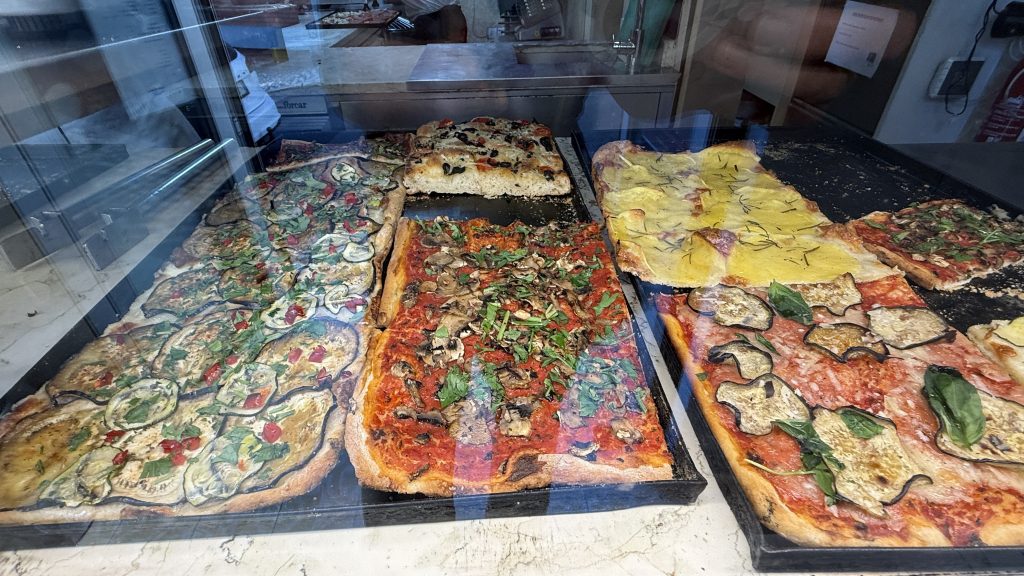
Just a few doors down from La Pizza di Nanna was Nannarella, one of Lisbon’s most talked-about gelato shops. Established in 2013 by Costanza Ventura, a Roman who moved to Lisbon and decided the city needed true artisanal gelato. Despite the buzz, there was only one person ahead of me. I ordered two scoops—dark chocolate and strawberry cheesecake. Both were delicious, but I especially loved the cheesecake.
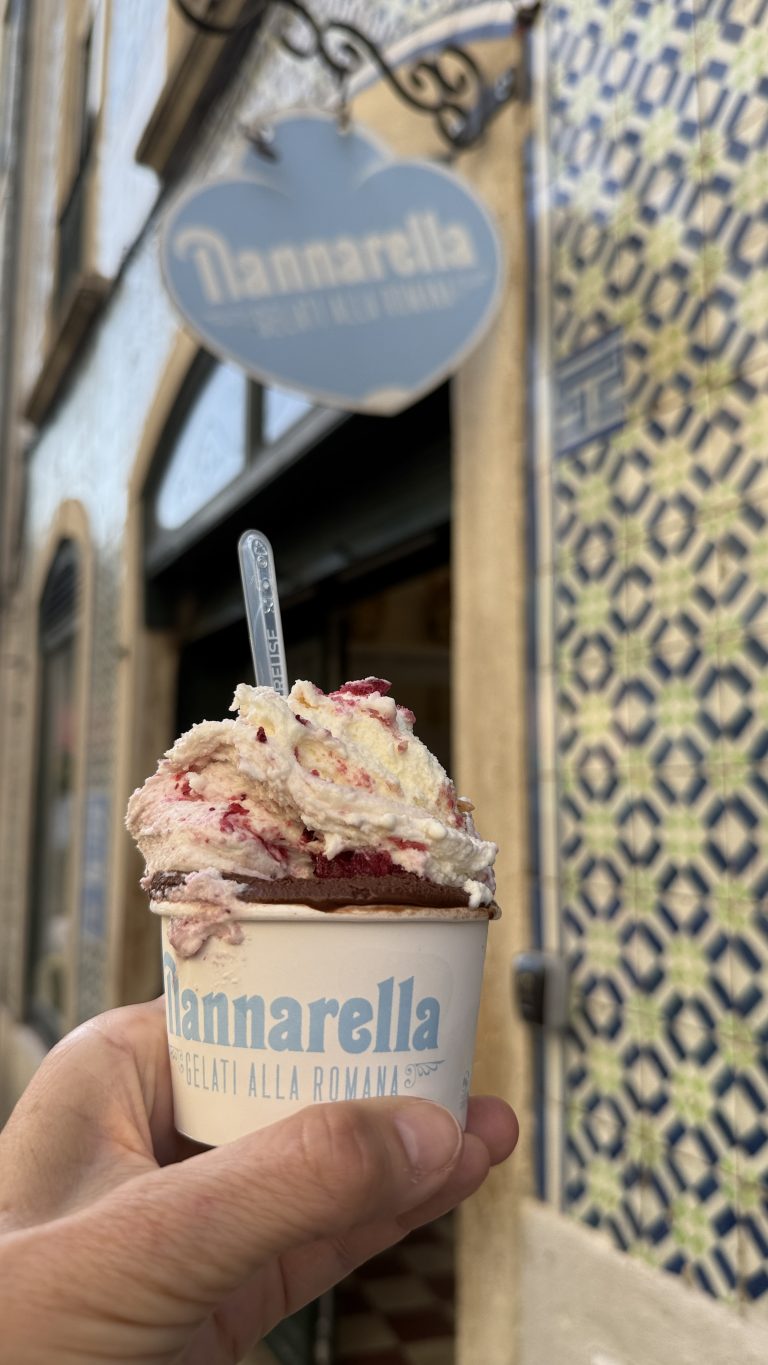
Fueled by pizza and gelato, I wandered back toward Rua Augusta, the grand pedestrian street that ends at the Arco da Rua Augusta. The ornate triumphal arch opens into Praça do Comércio, Lisbon’s riverside square, its black-and-white calçada portuguesa stonework adding to the beauty of the place.
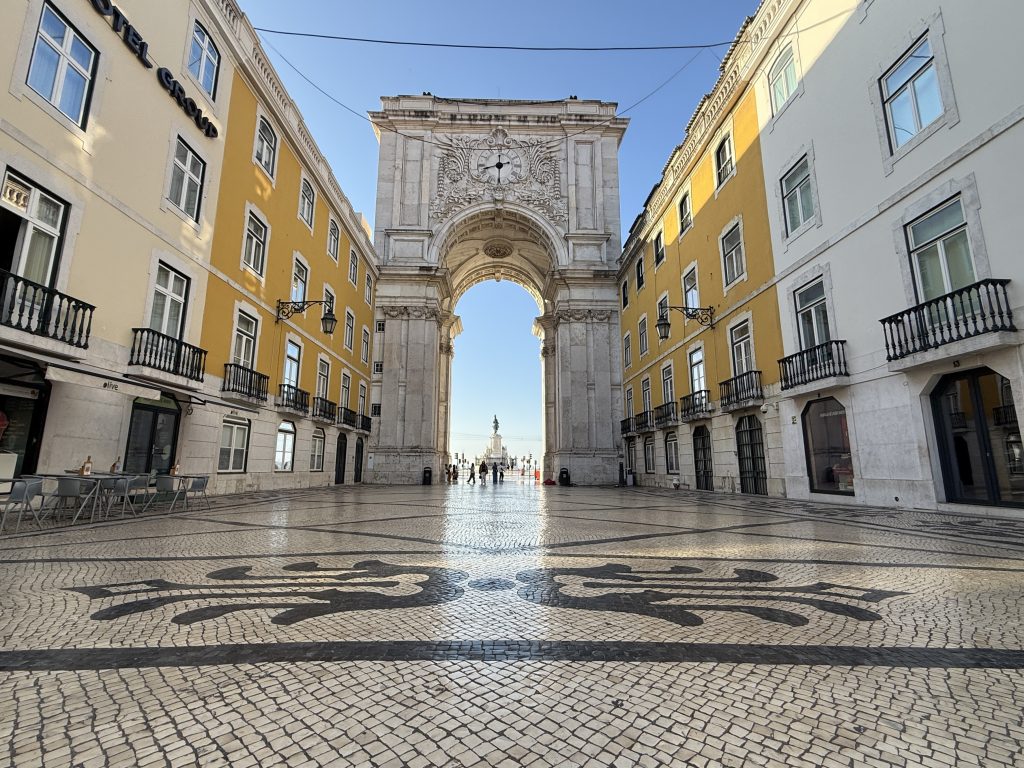
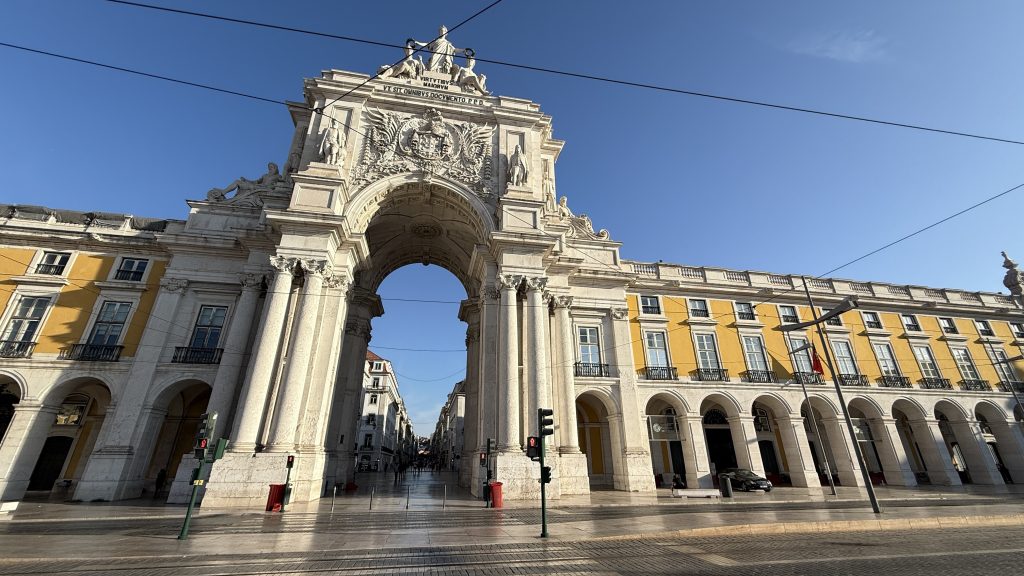
From the square, I kept wandering, stopping in a few shops here and there, including O Mundo Fantástico da Sardinha Portuguesa, where the walls are stacked floor to ceiling with colorful tins. The shelves held every variation of sardine you can imagine — in olive oil, tomato sauce, spicy piri-piri, or brightened with lemon. Part souvenir shop, part pantry staple, it was too fun not to take in.
Outside, the famous Tram 28 rattled past, squeezing through impossibly narrow streets — pure Lisbon.
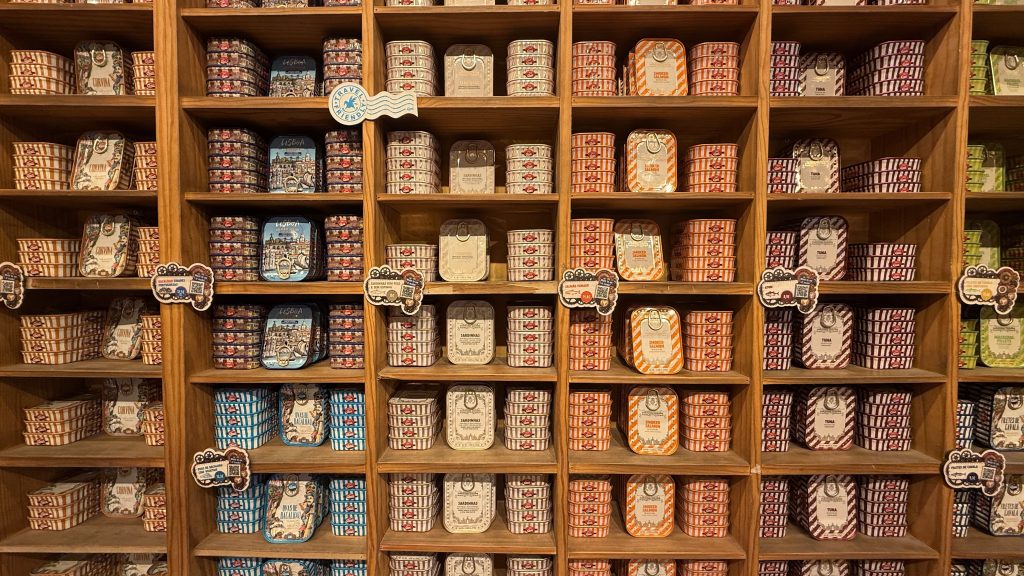
Later that evening, I climbed up to Castelo de São Jorge, the fortress I’d seen earlier from the Miradouro de São Pedro de Alcântara (Viewpoint of Saint Peter of Alcântara). Dating to the 11th century, it’s mostly ruins of walls and towers now, but walking the ramparts gave me a sense of how much ground it once covered.
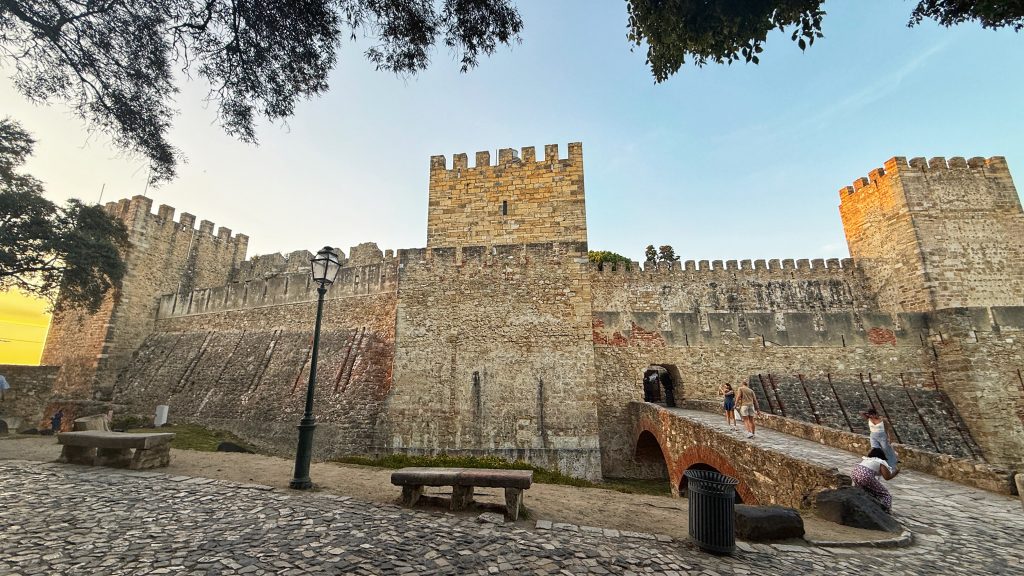
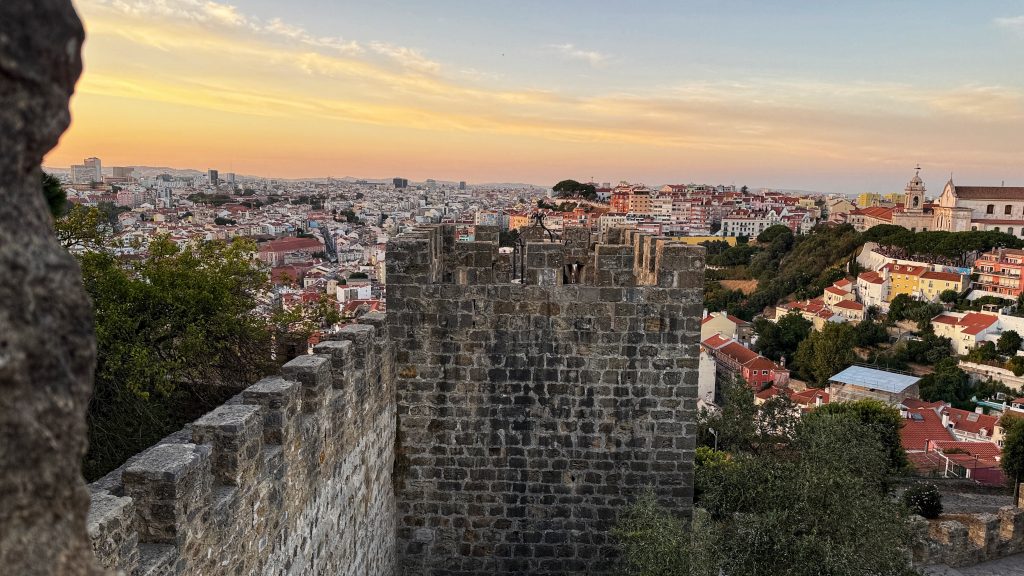
On the way back down from São Jorge Castle, I stopped at Ginjinha do Castelo, a tiny bar just outside the gates, for a Lisbon tradition: a quick shot of ginjinha, the local cherry liqueur. Served com elas — with cherries — it was sweet, strong, and the perfect way to end my first day.
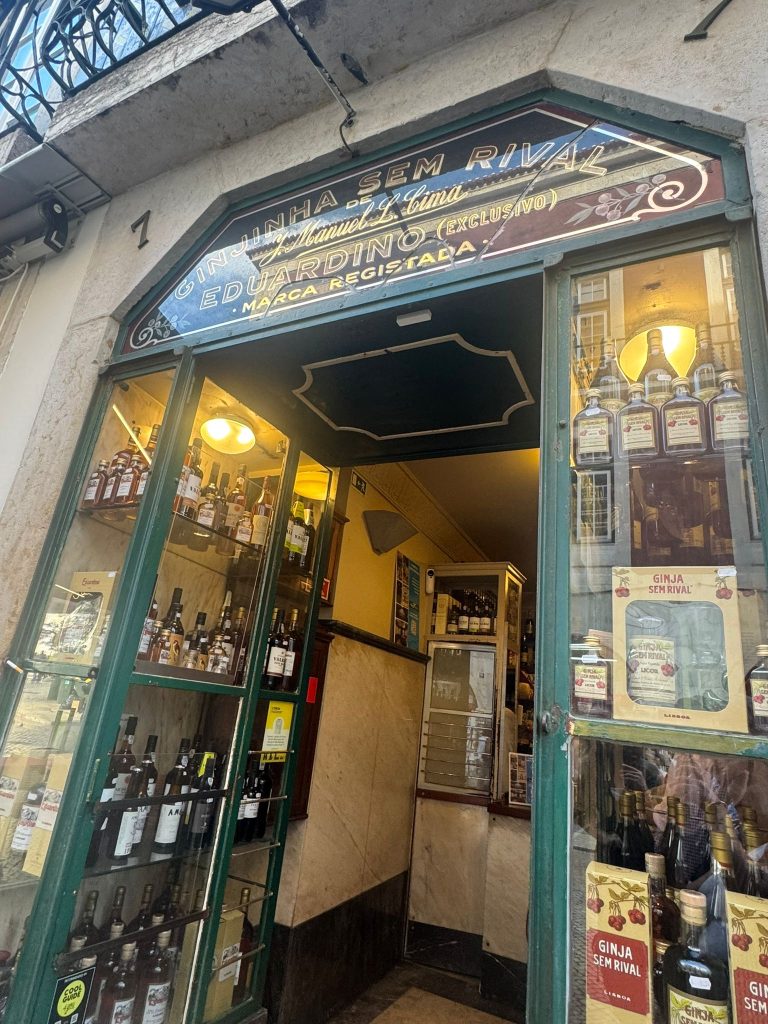
I started the morning at the waterfront, then walked over to the Lisbon Cathedral (Sé de Lisboa). From the outside, with its twin towers and rose window, it reminded me of a smaller Notre Dame. Inside, it felt heavy and Romanesque — cool stone, dim light, soaring arches — with flashes of color from stained glass. It’s Lisbon’s oldest church, first built in the 12th century and reshaped many times since.
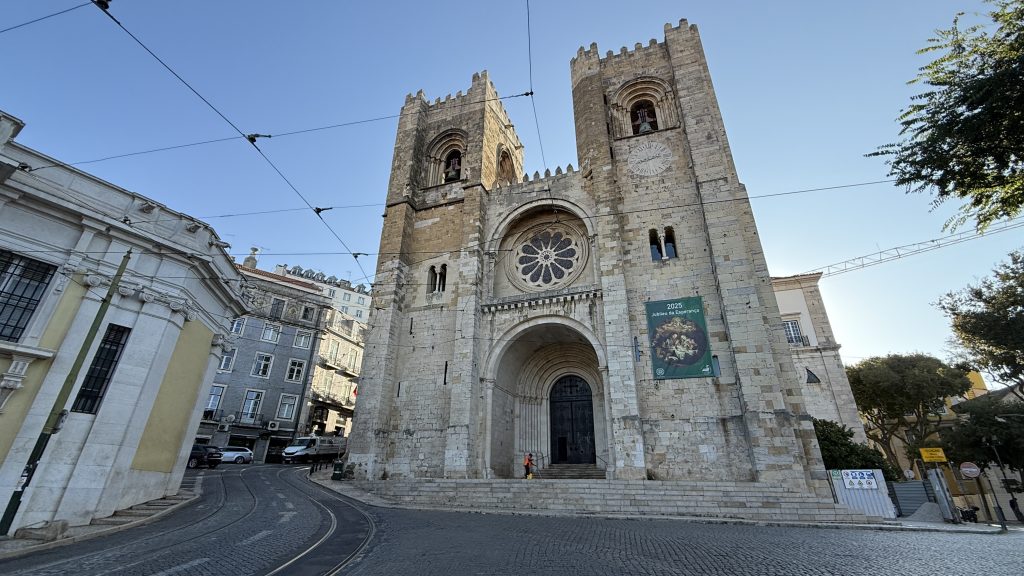
As I kept walking, I came across a mosaic cobblestone portrait of Amália Rodrigues, Portugal’s most beloved fado singer, created by Vhils, one of my favorite artists. He’s a Lisbon-born visual artist best known for his large-scale street art.
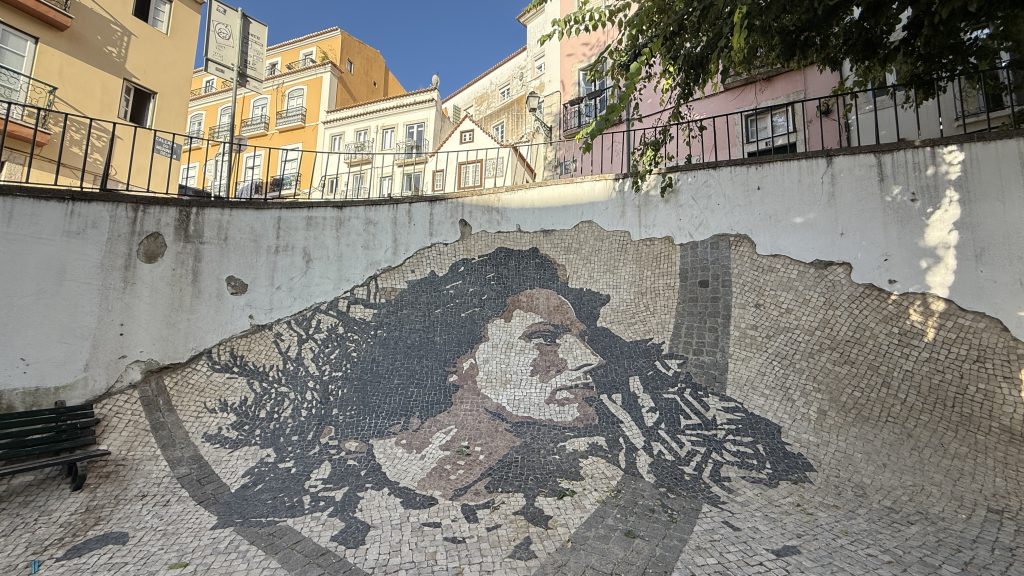
From there I headed to Rossio Square, one of Lisbon’s great public spaces — a meeting point for centuries. On one side stands the 19th-century National Theatre (Teatro Nacional Dona Maria II), built on the site of a former Inquisition palace.
Across the square, cafés and restaurants line the arcades under tiled buildings. In the center rises a tall column topped with King Pedro IV, flanked by two ornate fountains. The square itself is stunning, paved in Portugal’s signature wave-patterned tiles.
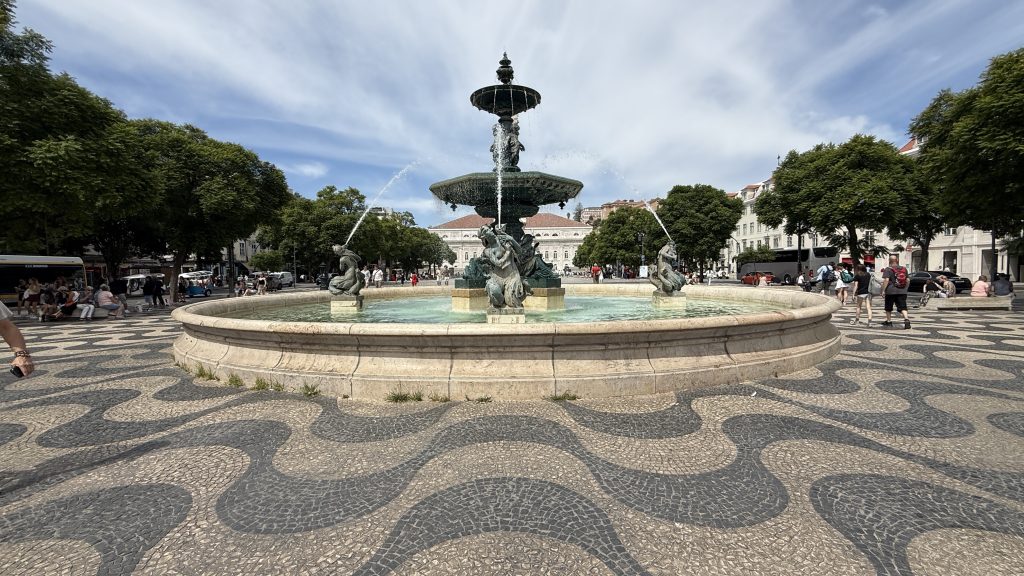
I had actually come here hoping to see another Vhils mural inside the opera house, but it was closed. Still, Rossio turned out to be the perfect spot to grab a quick breakfast watch the square come to life over breakfast before moving on.
After breakfast I passed by the distinctive Rossio Train Station, with its horseshoe-shaped arches, then wound through narrow streets of tiled façades and wrought-iron balconies. I reached the Monastery of São Vicente de Fora, continuing on through the Arco Grande de Cima toward Lisbon’s flea market.
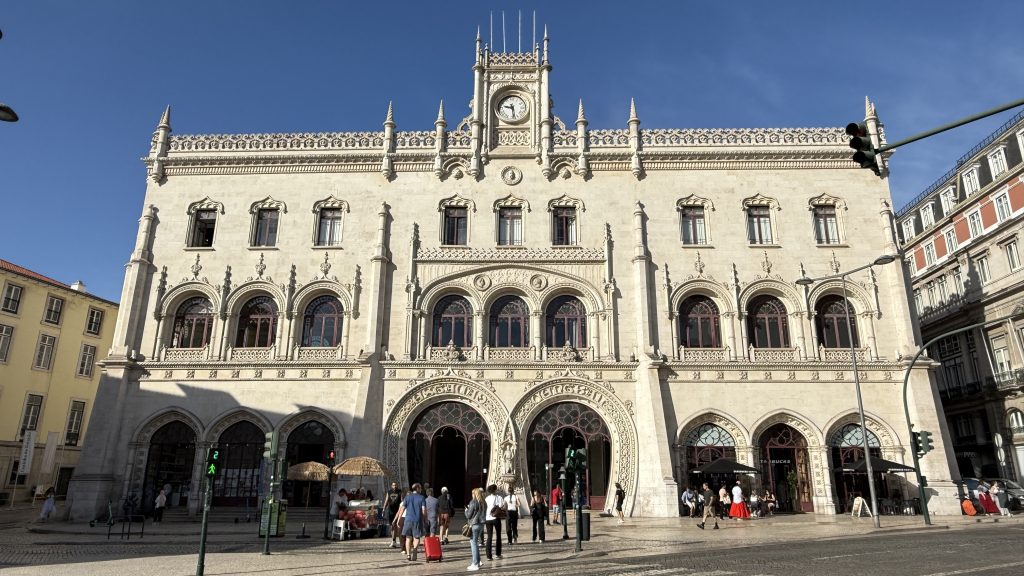
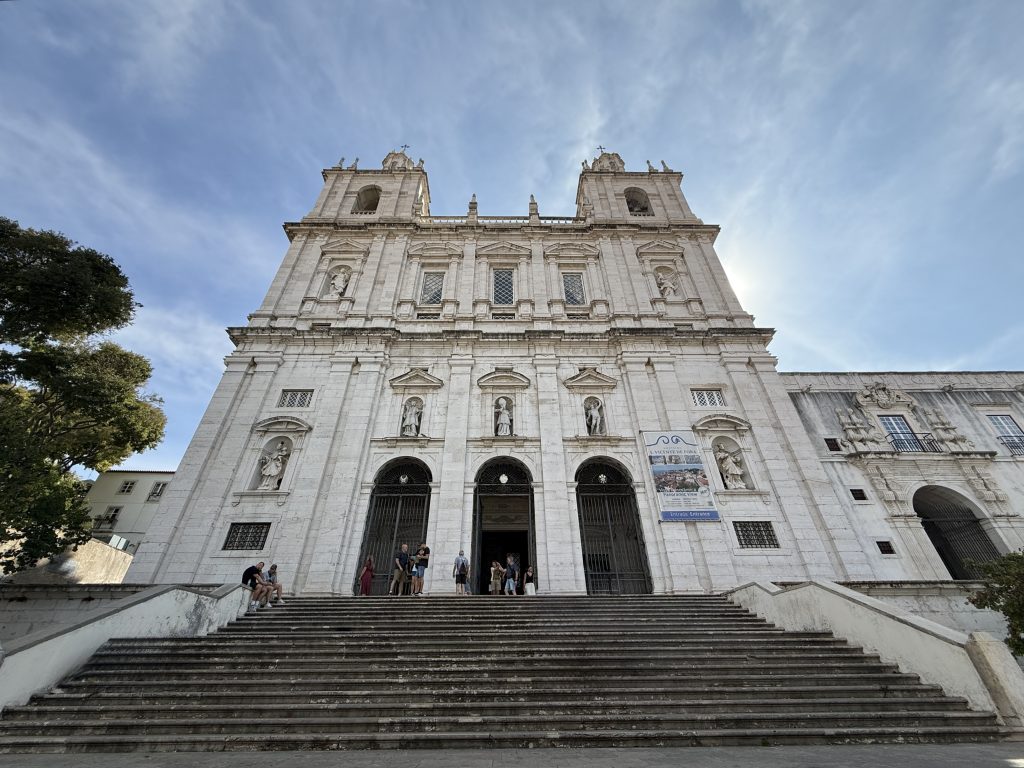
The Feira da Ladra — literally the “Thieves’ Market” — is Lisbon’s legendary flea market, and it only happens on Tuesdays and Saturdays. Lucky for me, it was Saturday. Tables were covered with antique tiles, old coins, secondhand clothes, postcards, mismatched silverware, and piles of books. As for the name, there are a couple of explanations: some say it came from the old rumor that stolen goods were once sold here, others suggest it’s just the classic ‘flea market’ idea of secondhand clothes and objects carrying fleas.
Who knows if either story is really true, but the market itself has been around for more than a century.
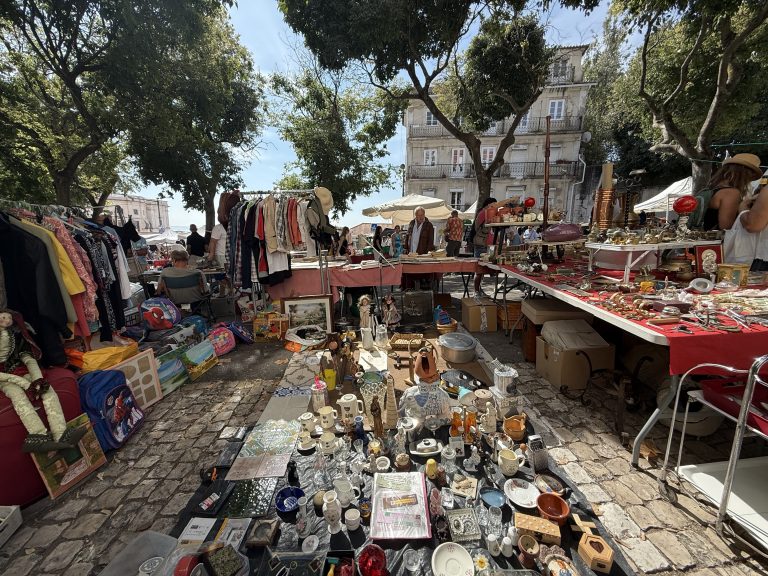
Just above the market stands the National Pantheon, its white dome visible across the city. Originally a 17th-century church, it’s now the resting place for some of Portugal’s most famous figures — including fado singer Amália Rodrigues, whose mosaic portrait I’d passed earlier in the day. Presidents, writers, and explorers are buried there too.
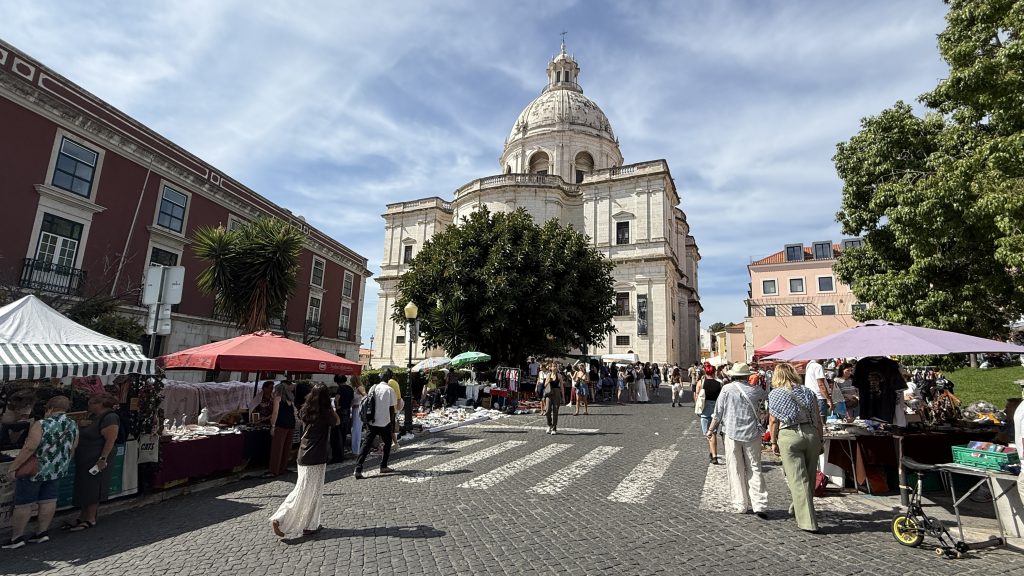
From the market, I let my GPS lead me to a massive collaborative mural by Vhils and Shepard Fairey, called Universal Personhood. Afterward, I climbed a steep hill to the Miradouro da Senhora do Monte (Viewpoint of Our Lady of the Hill), another of Lisbon’s great viewpoints.
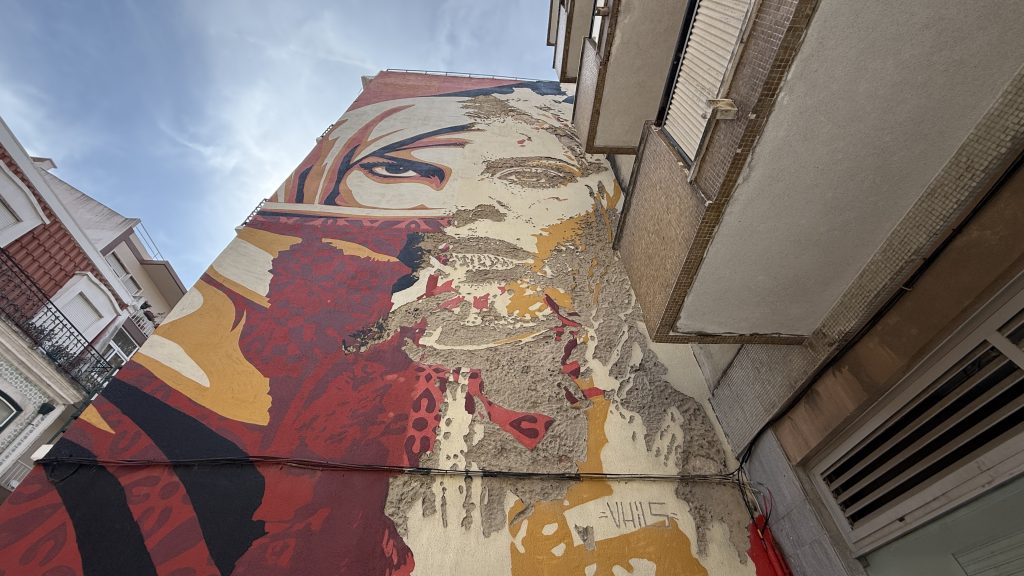
I made my way to the São José neighborhood for lunch at a tiny restaurant called Jesus é Goes, another “Phil” stop. The restaurant is small — only about 18 seats — and by luck I slipped in just before its lunch closing. As a vegetarian, the options were limited, but enough. I ordered daal with chapati, followed by a date samosa with ginger-cardamom ice cream.
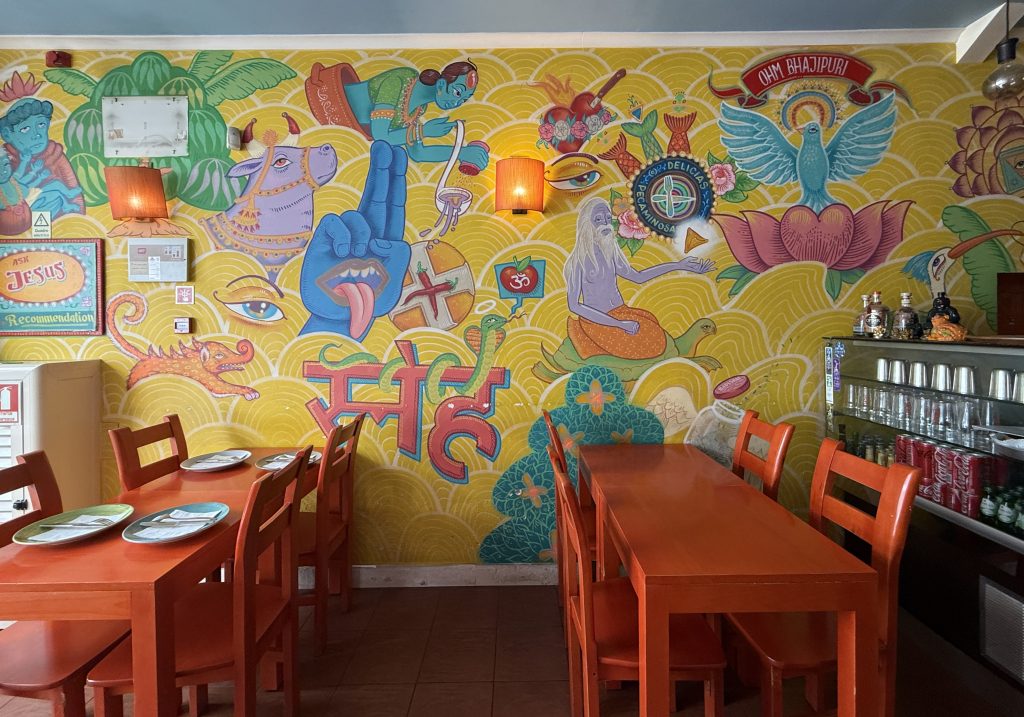
The chef, Jesus Lee Fernandes, came from Goa, India, a region once under Portuguese rule. His cooking carried that mix of Indian flavors and Portuguese influence. When I didn’t see him, I asked — and learned from the waiter that he had passed away a few years ago. The restaurant, though, still carries his recipes forward.
After lunch, I circled back to the Monastery of São Vicente de Fora. From the outside, it’s imposing enough, but stepping inside completely blew me away. Nearly every surface is covered in azulejos: corridors lined with blue-and-white panels, cloisters where every wall along the arcades is tiled, including 28 panels depicting La Fontaine’s fables, alongside others illustrating biblical scenes. I climbed up to the rooftop terrace, where the view stretched wide across the city.
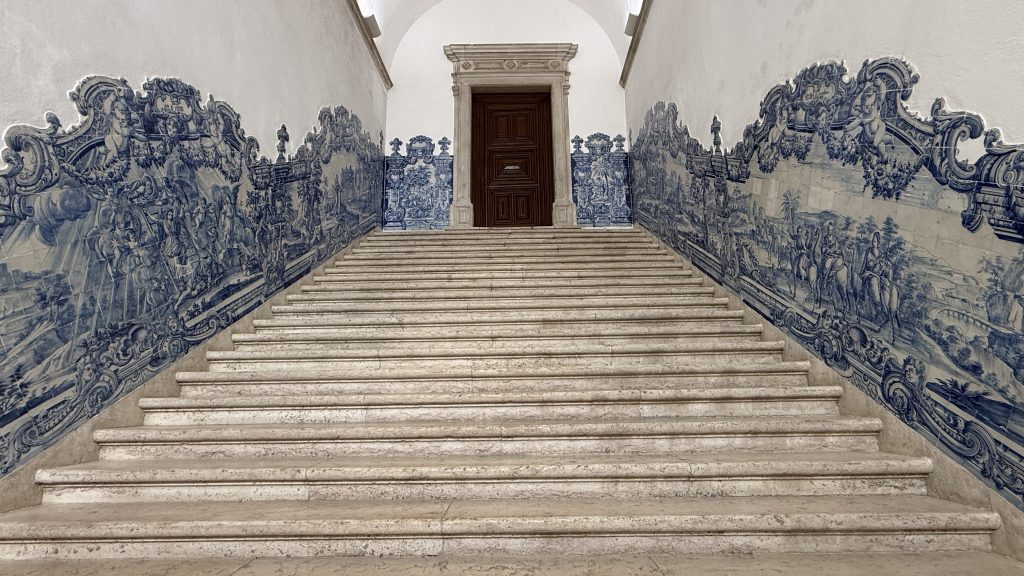
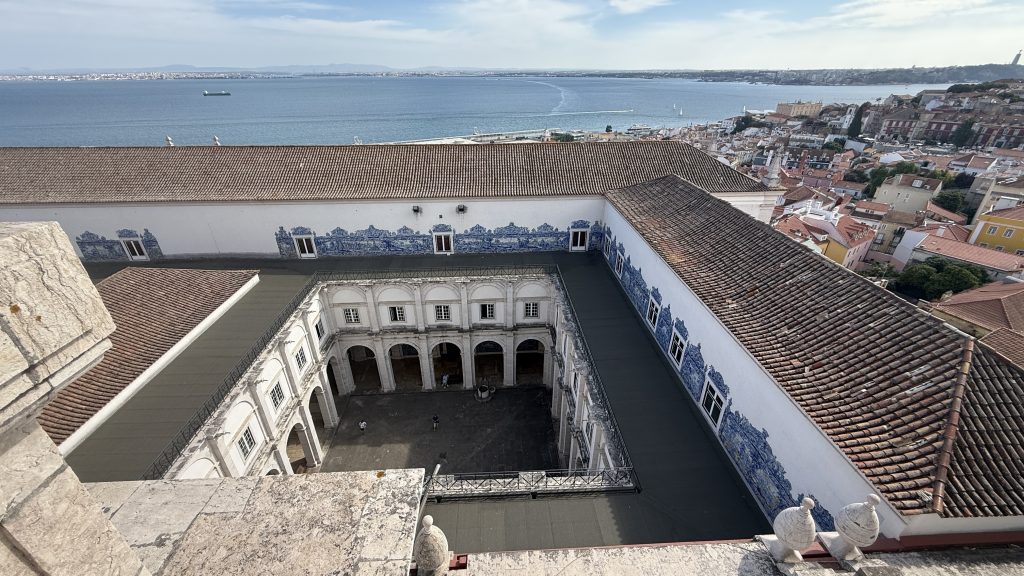
Before arriving in Lisbon, I booked a sidecar tour with Bike My Side. A mix-up with the start time meant we set off later than planned, but once the engine roared, I forgot about the delay. Riding in the sidecar was definitely a new experience — helmet snug, hair blowing, bumping along Lisbon’s cobbled streets with the city right there at eye level.
In just a few hours, we covered more ground than I ever could have on foot: Alfama’s narrow lanes, Chiado’s boulevards, Bairro Alto’s lively hills, and Belém by the river. We passed most of the landmarks I had already seen — the Pantheon, Lisbon’s first church, and the castle — along with plenty of new places I hadn’t.
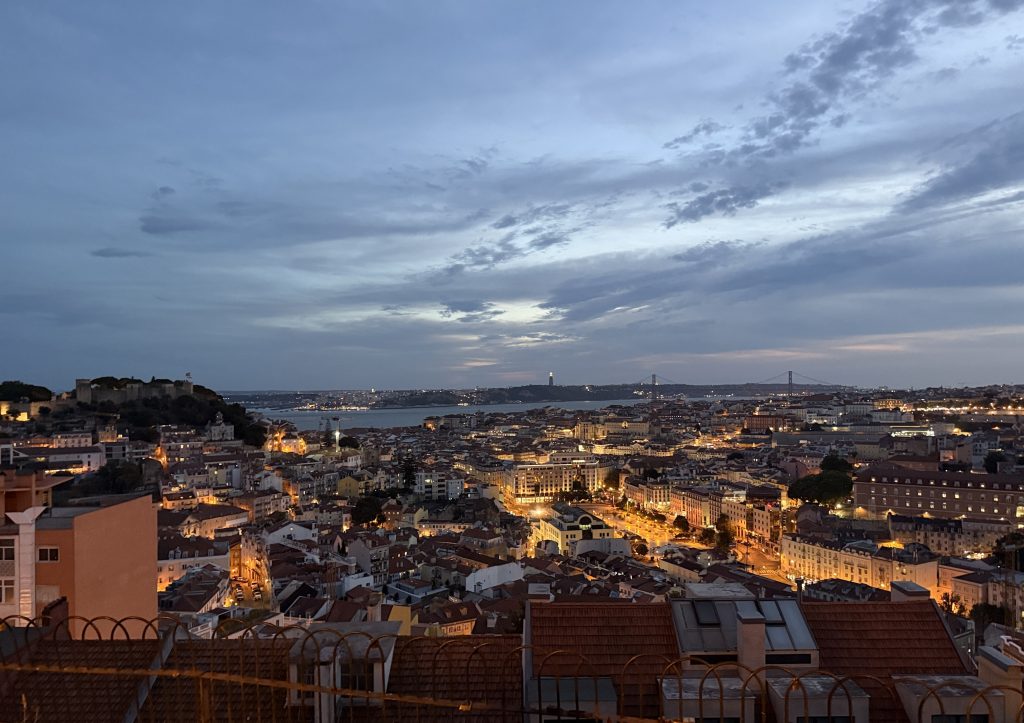
We stopped at Jerónimos Monastery, Belém Tower, the Monument to the Discoveries, and crossed viewpoints from Parque Eduardo VII to the 25 de Abril Bridge with its Christ the King statue across the water — and even some spots too far out to stumble across on my own. We even pulled into LX Factory, a former industrial site turned creative hub, where I wandered around a bit and grabbed a quick coffee before moving on.
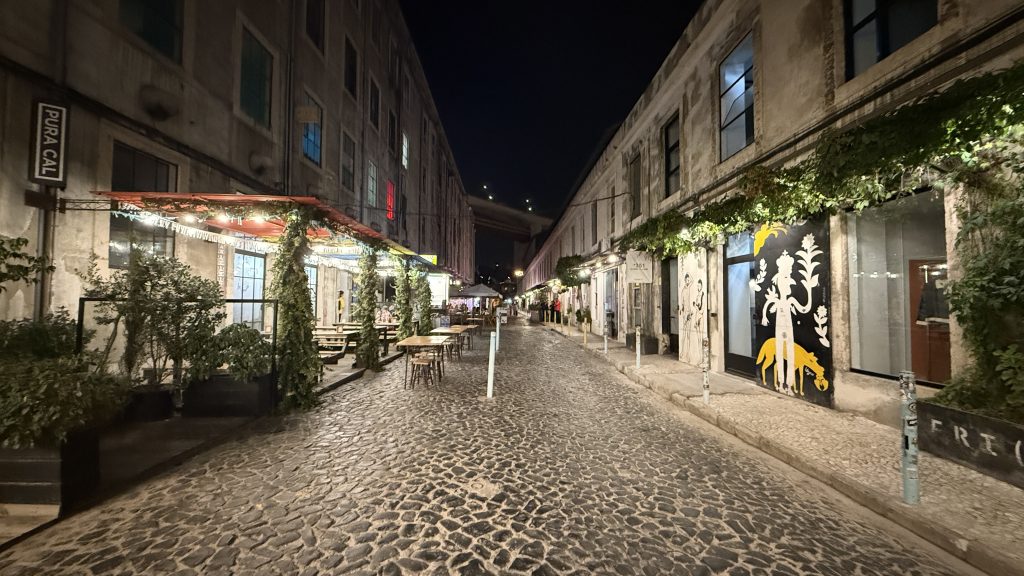
The ride was supposed to be three hours, but my driver just kept going — closer to four by the time I climbed out. Since we’d started late, it was already getting dark, so I didn’t come away with the photos I’d hoped to take. Maybe that was for the best. It pushed me to put my phone away and just enjoy the ride, city lights flashing past as we bumped along. Late start, long ride, barely any photos — and still one of my favorite experiences in the city.
No trip to Lisbon ever feels complete without at least a day in Sintra. So, for Day 3 I took the 40-minute train to Sintra, a hill town known for its lush setting and palaces.
I headed straight for the Palácio Nacional da Pena, painted in bold shades of orange, yellow, and gray. Built in the 19th century on the ruins of a monastery and dreamed up by King Ferdinand II, it mixes Gothic, Moorish, and Romantic styles in a way that felt whimsical, almost storybook-like, but still magical. My favorite detail was one of the windows, framed by a giant shell and topped with a stone figure that looked half-troll, half-sea god.
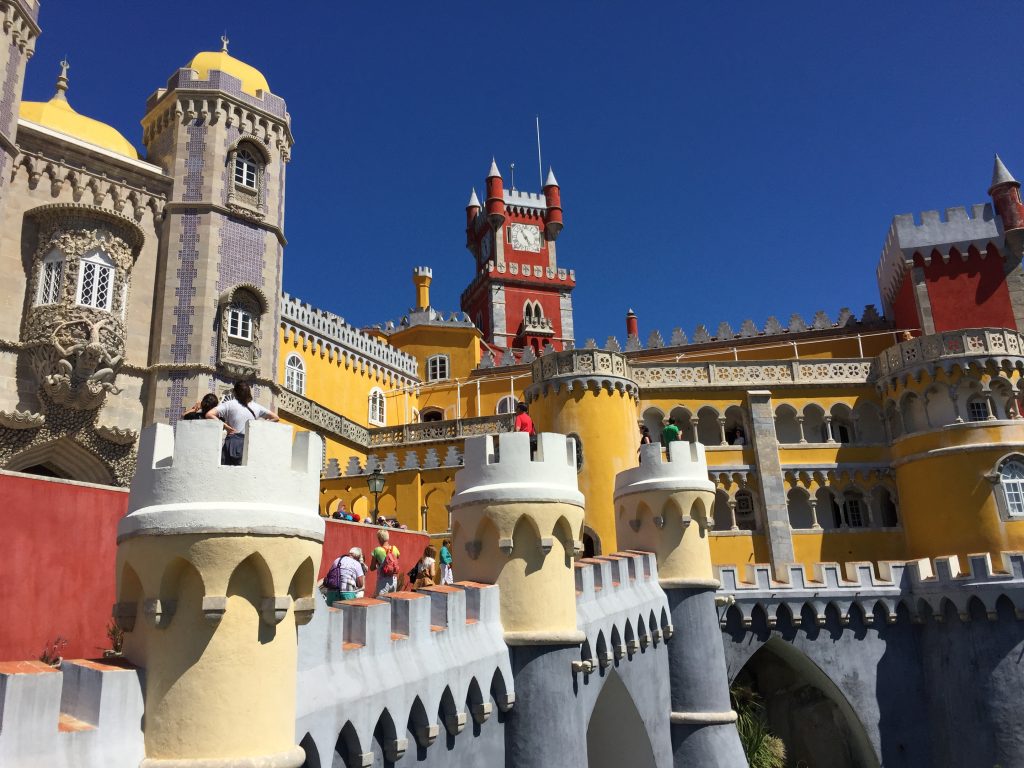
Inside, the palace was just as much of a mash-up. Some rooms were lined with colorful azulejos in different patterns, others with painted ceilings and carved stone details. Even the tiles varied from space to space — geometric in one room, floral in another. It felt like each corner was trying on a different style, and somehow it all worked together.
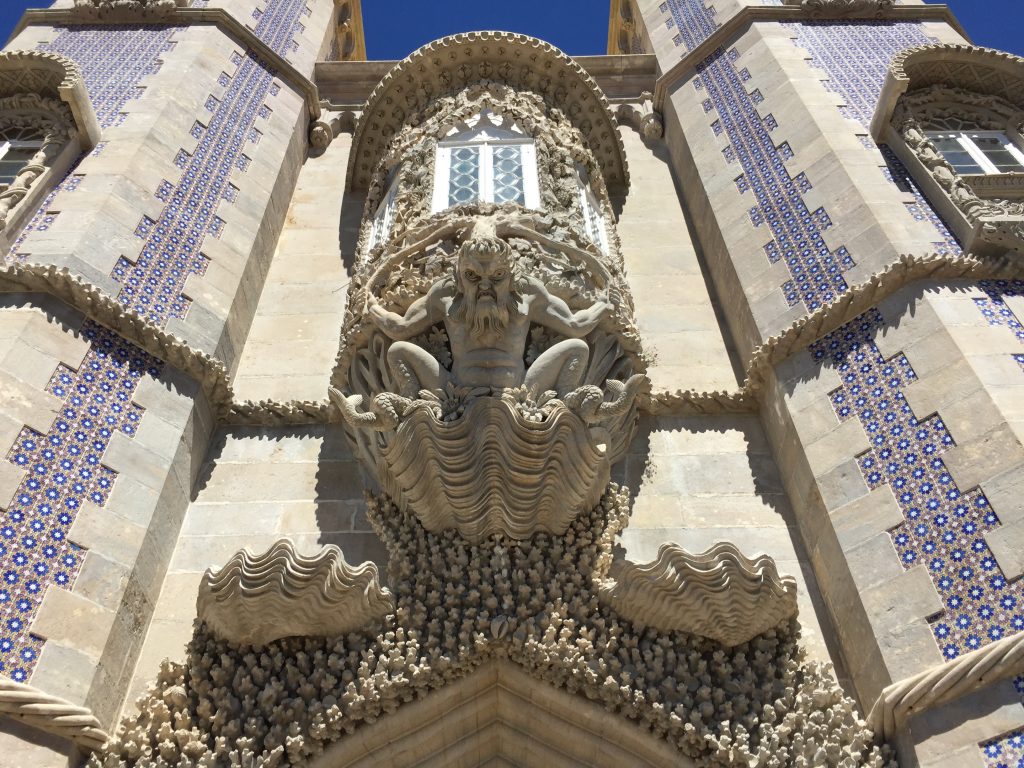
I didn’t have much more time to linger — I had to get back to Lisbon to meet up with my hiking group. Back in the city, I stopped at Igreja de Santo António de Lisboa, a small church built on the spot where Saint Anthony was born. And, on Rua do Salvador, I went looking for a stone plaque dated 1686 I’d read about, said to be Lisbon’s oldest surviving street sign, and found it still marking the corner.
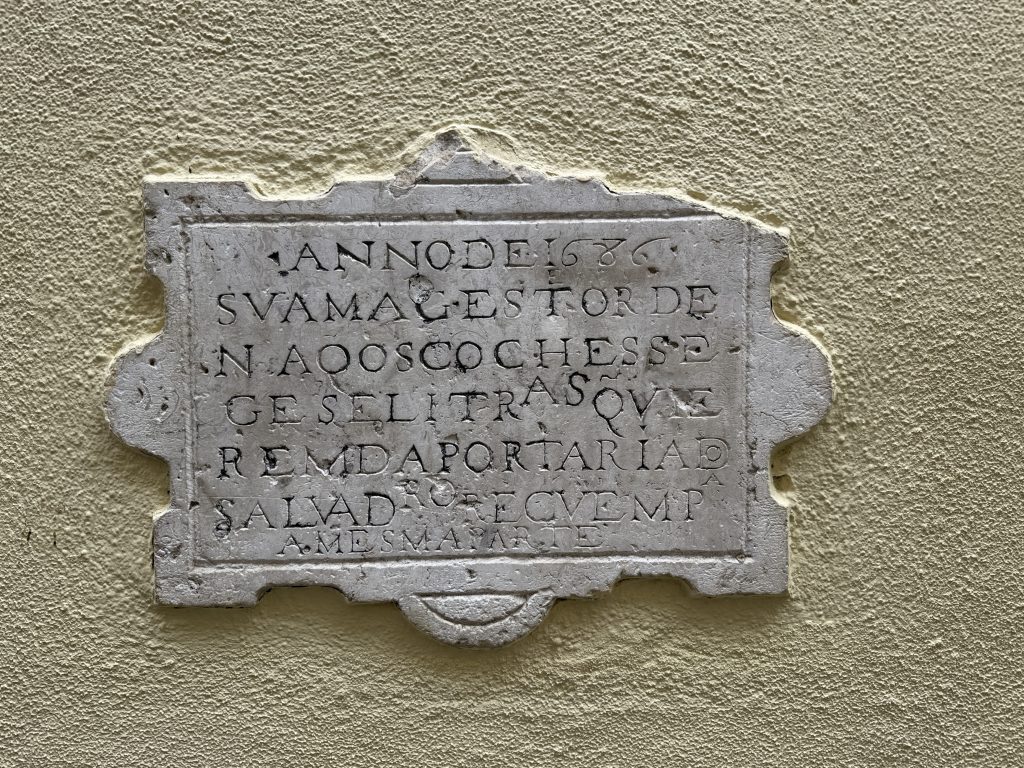
Before I knew it, it was time for me to head over to Moov Hotel Lisboa Oriente, the base hotel for my hiking trip, which started the next day. I like Intrepid, but I never understand why they pick a hotel so far from the city. The area, Parque das Nações, is modern and wide open, completely redeveloped for Expo ’98 — a stark contrast to Lisbon’s historic center, all glass and open spaces instead of tiled alleys.
I left Sagres around noon for the 3.5-hour drive back to Lisbon (I booked this through DayTrip — the bus would’ve been much cheaper, but sometimes I just want convenience).
For the last part of my trip, I stayed at Chiado 44, a small guesthouse right in the heart of the district. The location couldn’t have been better — an easy walk to Baixa and Bairro Alto. My room was simple but stylish, with doors that opened onto a tiny patio and even a glimpse of the river.
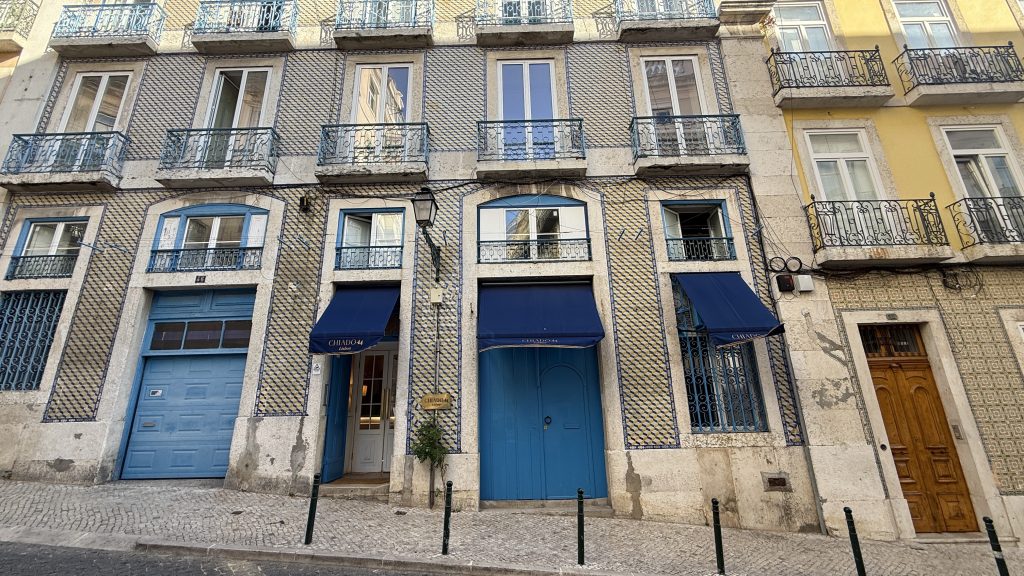
That evening I booked a tasting at Lisbon Winery, Our small group — me, a couple from Ohio, and another from Northern Ireland — started with an olive oil flight. Three bottles from different regions showed just how distinct olive oils can be: one light and grassy, another fuller and aromatic, the last with a peppery bite that lingered.
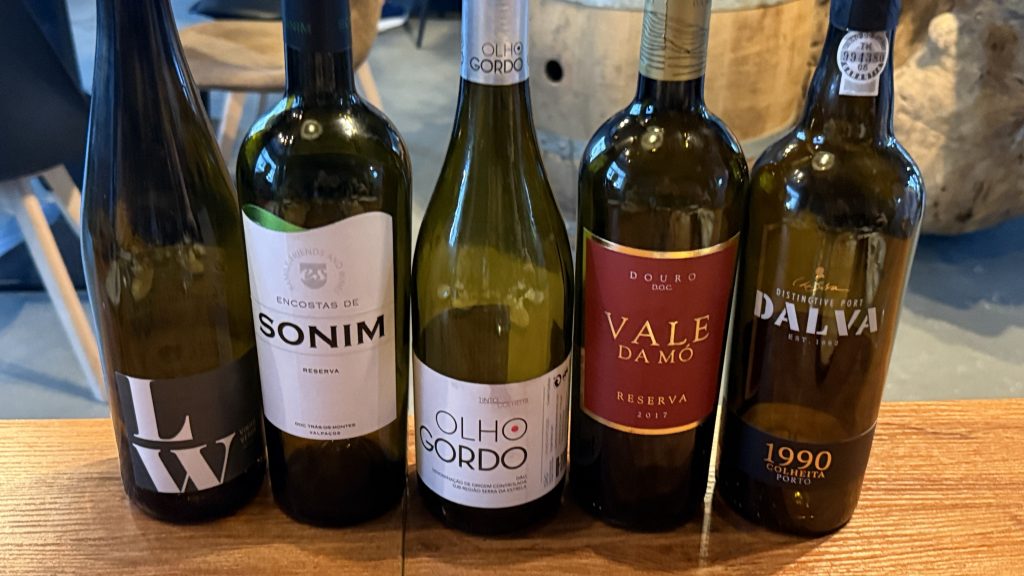
Then came the wines. We began with a crisp Vinho Verde, moved to a mineral-driven white from the north, then onto the reds: one soft and fruity, the next a Douro with real depth. A vegetarian charcuterie board arrived just for me — cheeses, crackers, sweet potato chips, and a silky pumpkin jam so good it could’ve been dinner on its own. In fact, it was.
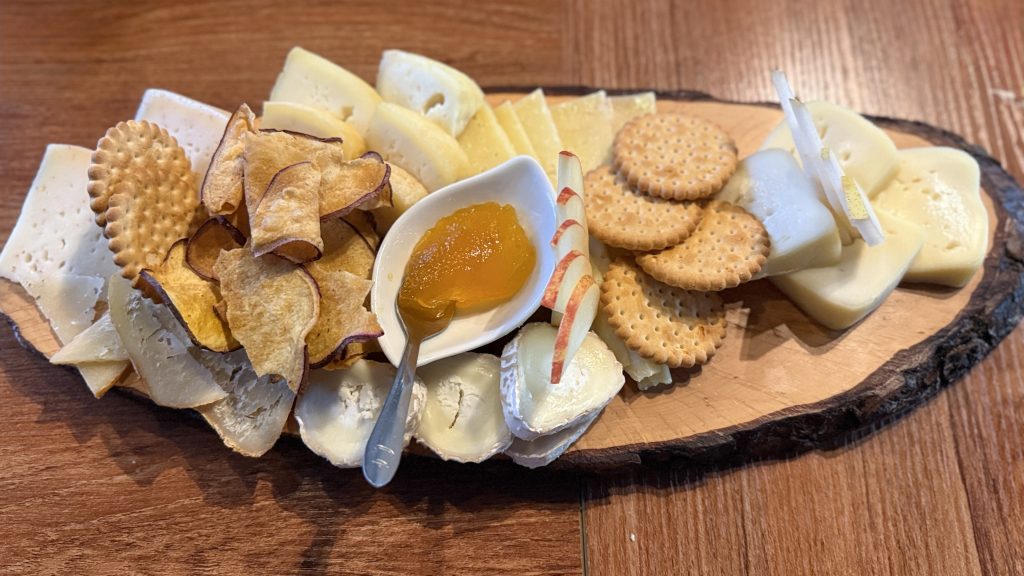
We ended with a 1990 Dalva Colheita Port, aged 35 years in oak, tawny and amber, with flavors that stretched from figs to caramel. Just a sip, but unforgettable. The whole experience lasted about two hours, and it felt like time well spent. Funny thing is, I almost never drink port — the only other time was at a tasting on my last trip to Lisbon. And I don’t know why, because it’s really very enjoyable, especially the way it forces you to slow down and savor each sip.
With a little wine buzz, I wandered back through Chiado’s lit-up streets and stopped at Nannarella for another scoop of gelato — the perfect nightcap.
I started my morning at Copenhagen Coffee Lab, where I had breakfast with the most delicious cortado. From there, I headed over to Time Out Market, a massive food hall in Cais do Sodré, right by the train station and ferry port. It’s a great spot if you want to sample a bunch of different Portuguese dishes all under one roof. I just wandered around, taking in the scene.
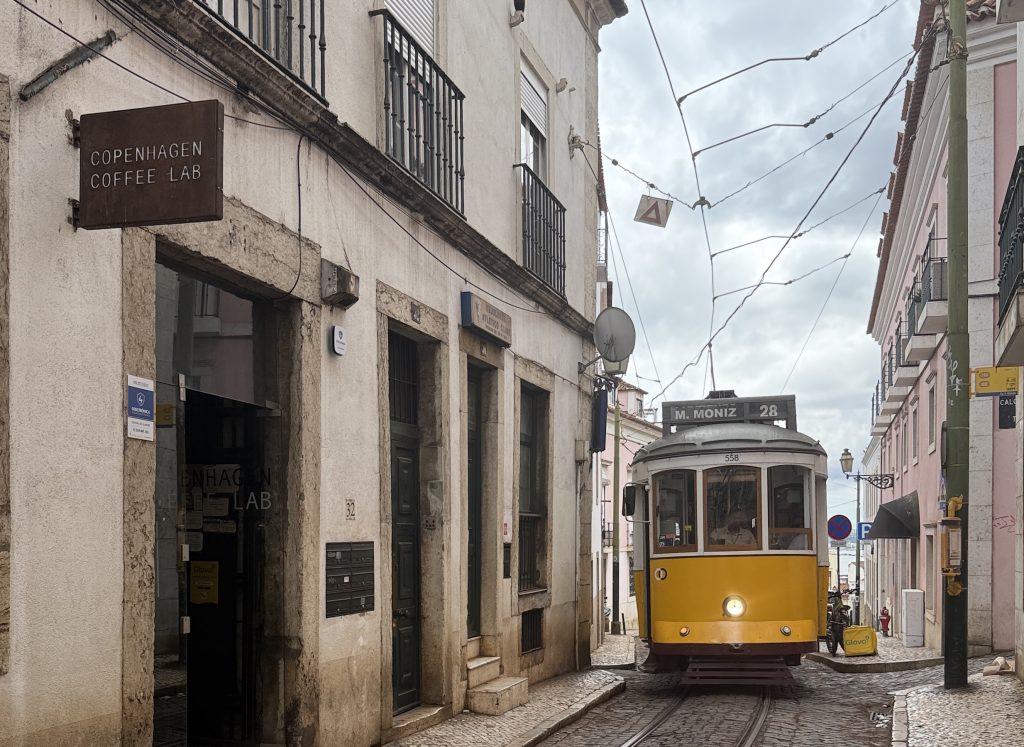
I cut down through Misericórdia, another neighborhood with some of the most beautiful mosaic sidewalks I’d seen yet, and then walked along Pink Street. Once Lisbon’s red-light district, it’s now been reinvented into one of the city’s nightlife hubs — bars, clubs, and late-night cafés line the block. When I walked through in the daytime, it was quiet, but you could still feel its energy.
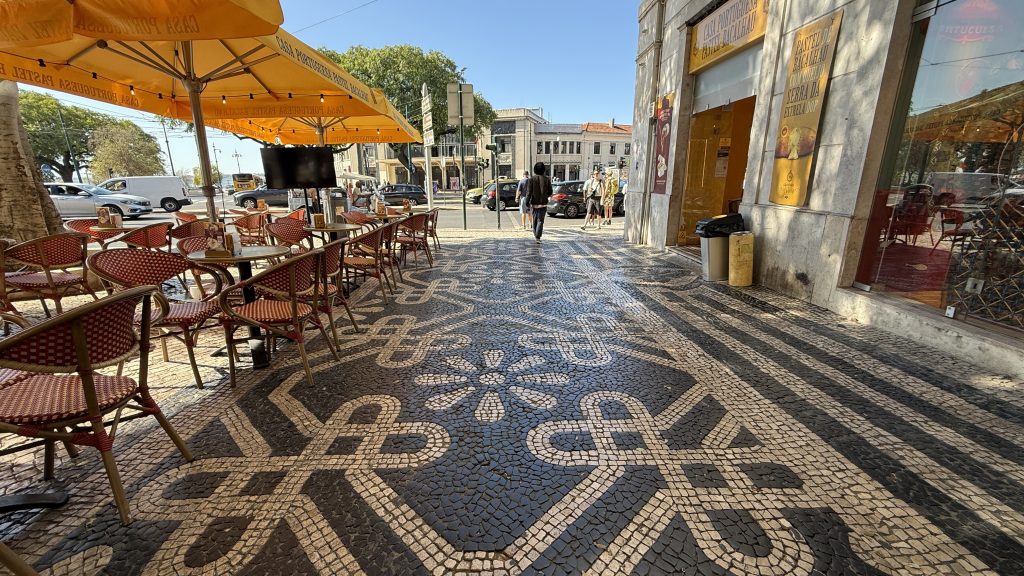
I then headed to Igreja do Loreto, a 16th-century church also known as the Italian Church, where I made the rookie mistake of not silencing my GPS volume before stepping inside. (Note to self: churches and Google Maps voice prompts do not mix well.) From there, I climbed up toward Graça, pausing in the plaza at Largo da Graça, where the statue of Padre António Vieira sits surrounded by yet another stunning mosaic pavement design.
One place on my list to visit today was Livraria Bertrand — recognized by Guinness World Records as the world’s oldest operating bookstore. It’s been open since 1732, meaning it’s been running for over 300 years. I even bought a couple of books to bring home.

Next up was one of Lisbon’s signatures: the pastel de nata. I stopped at Manteigaria, one of the city’s most popular bakeries for these custard tarts. Mine was still warm when I got it, and you’re supposed to sprinkle sugar and cinnamon on top — which I did — before biting into the flaky crust and creamy filling. It lived up to the hype. I paired it with an espresso at the bar, watching bakers pull tray after tray from the ovens.
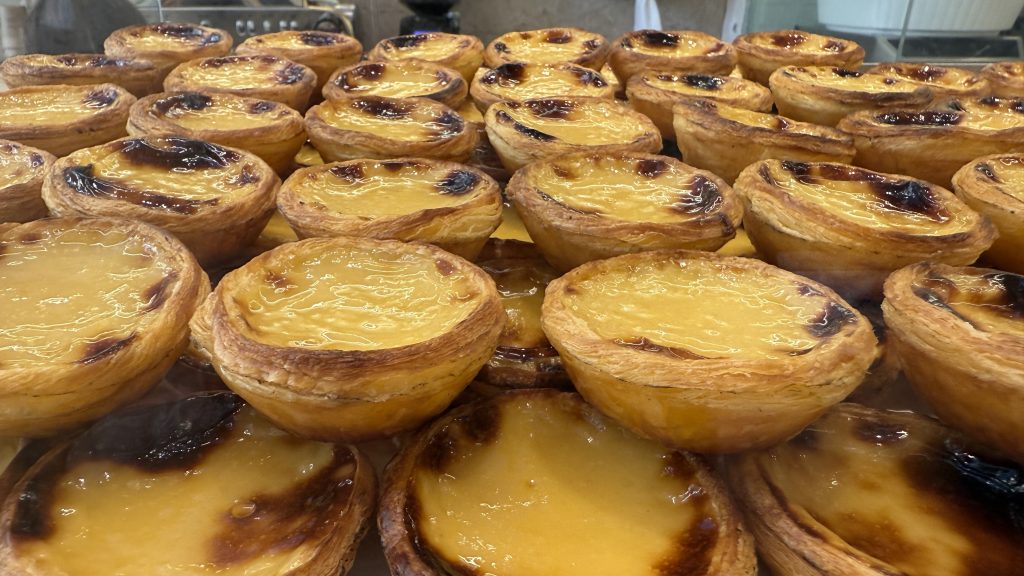
Four days in Lisbon and I still hadn’t ridden Lisbon’s Tram 28, even though I’d had plenty of chances. Since this was my last day, I figured it was finally time. The ride cost €3.20, and while it’s often crowded, I lucked into a seat and stayed on all the way to the last stop. Touristy, sure, but also classic Lisbon — the kind of thing you have to do at least once.Tram 28 is the most famous, but not the only one: locals also ride Tram 12 (a shorter loop through Alfama) and Tram 15 (which runs out toward Belém).
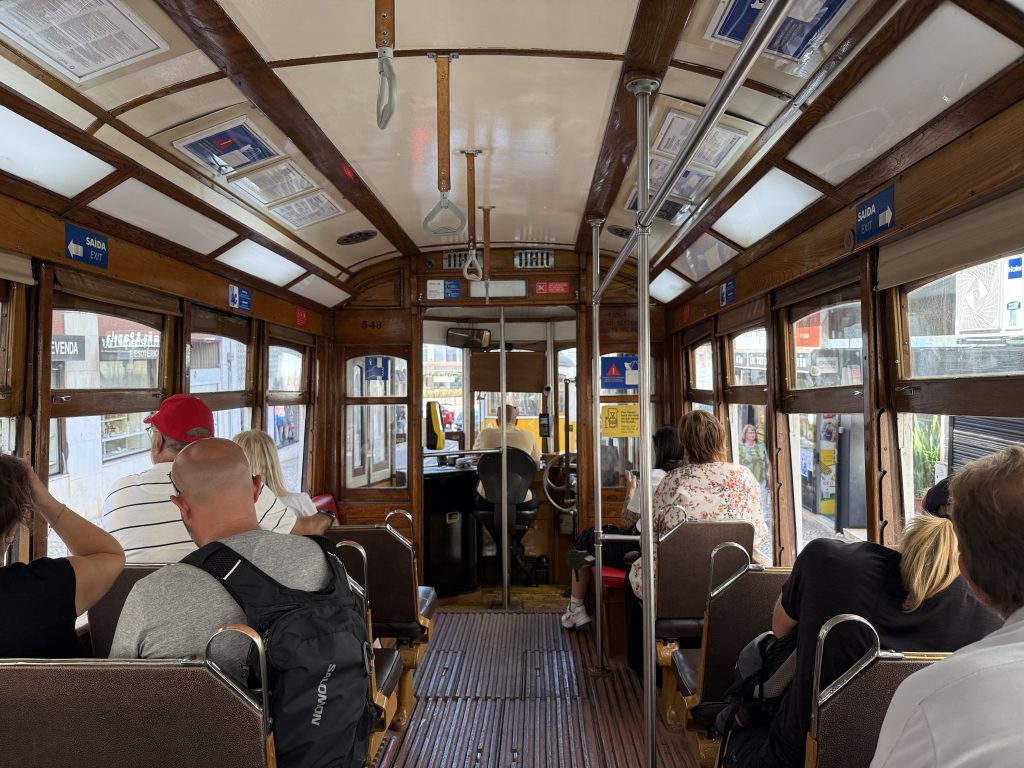
Lunch was at Vegan Food Project, a modern spot giving Portuguese classics a plant-based twist. I ordered a salad, a cheese board, and a glass of wine — it was all great.
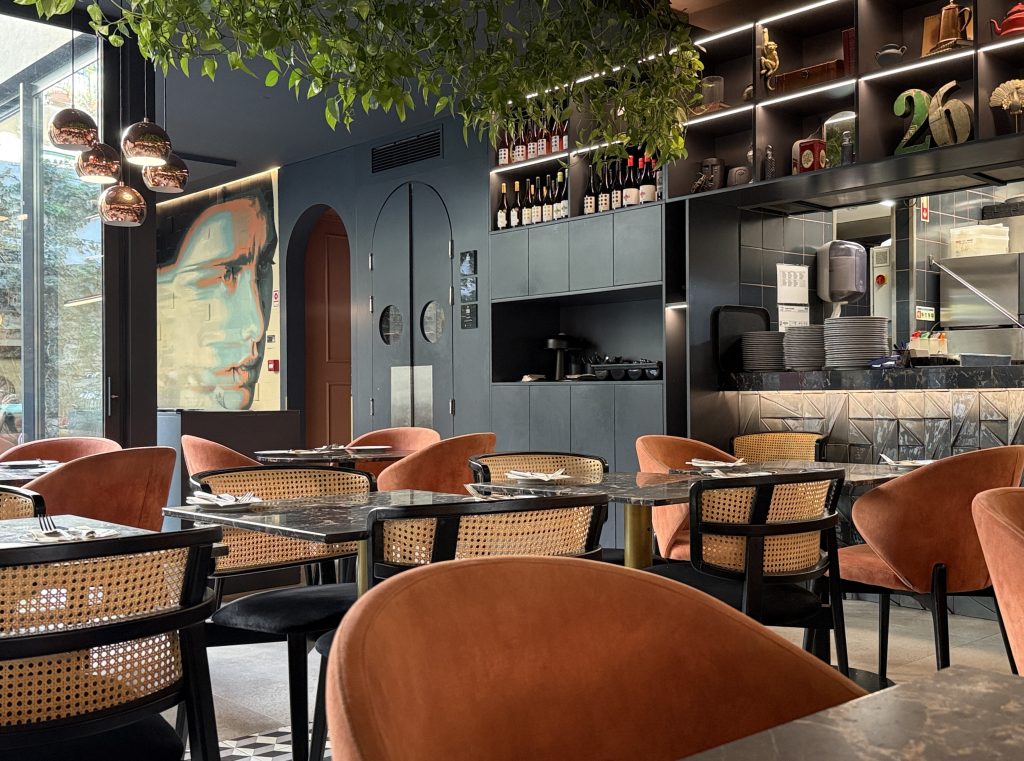
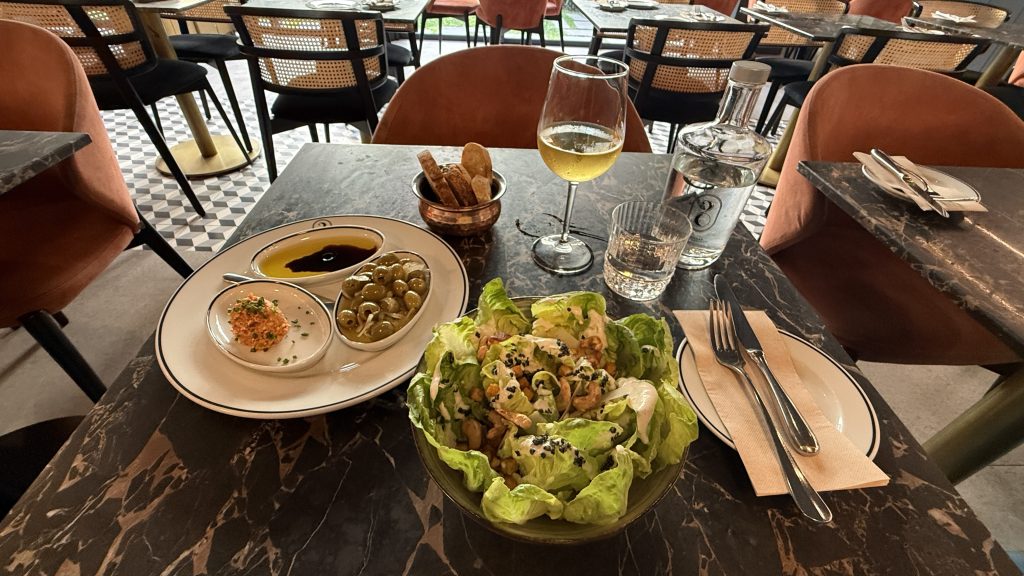
After lunch, I headed over to the Lapa neighborhood to see one of Lisbon’s most distinctive façades. Rather than being fully tiled, the decoration outlines the windows, doors, and roof in ornate 19th-century tilework — raised, colorful, and symbolic. The effect is dramatic, almost like a piece of architectural jewelry.
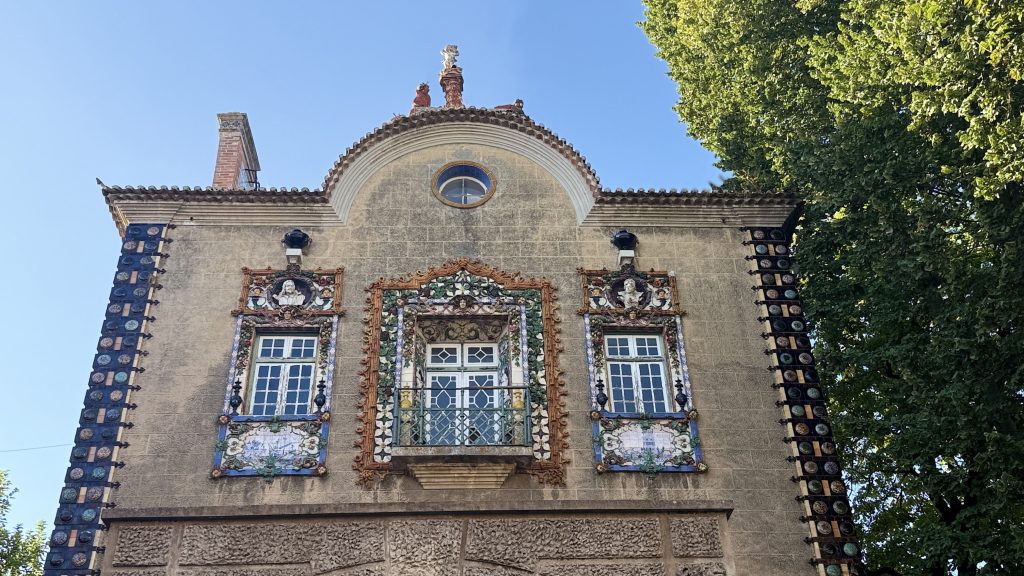
On the way back toward my hotel I browsed a few shops, treated myself to one more pastel de nata, and then reluctantly called it a night. I had a 3 a.m. airport transfer the next morning.
It felt too soon to leave Lisbon. There were still things I would have liked to do, but I left with that feeling of wanting more — which is probably the best way to leave a city. What struck me most was how Lisbon reminded me of San Francisco in little ways: the endless hills, the rattling trams, and the red suspension bridge over the river. The resemblance isn’t accidental — the 25 de Abril Bridge was built by the same American company that worked on San Francisco’s Bay Bridge. Still, Lisbon has its own history and character, and it’s very much its own place — one I know I’ll want to come back to.
Lisbon isn’t a city you neatly “do” one neighborhood at a time — at least I didn’t. I’d set out with one spot in mind and end up zigzagging into a totally different district. That’s part of the fun. Baixa flows right into Chiado, Alfama climbs into Graça, and before you know it you’ve covered three neighborhoods without even realizing it. So if my days here look a little mixed, that’s because that’s how Lisbon unfolded for me — one tiled street leading to the next.